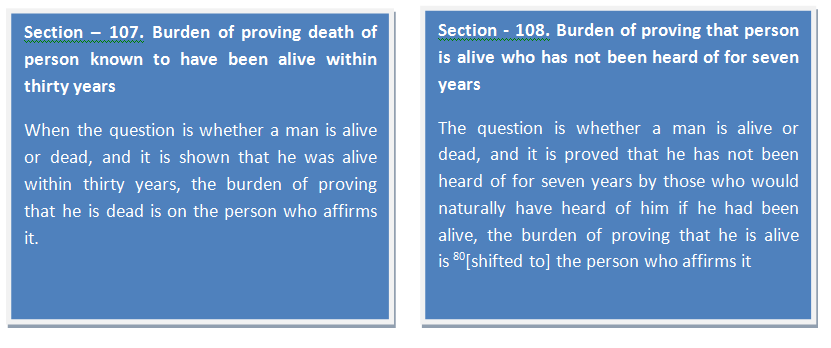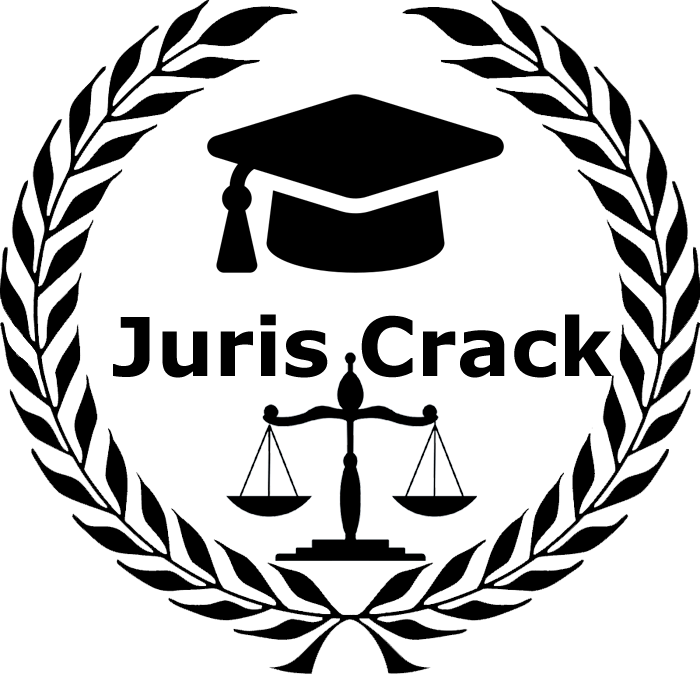Section –107 to 108 of Evidence Act
Burden of proof

Supreme Court in the L.I.C. Of India vs Anuradha on 26 March, 2004 interpreted both section 107 and 106
The law as to presumption of death remains the same whether in Common Law of England or in the statutory provisions contained in Sections 107 and 108 of the Indian Evidence Act, 1872. In the scheme of Evidence Act, though Sections 107 and 108 are drafted as two Sections, in effect, Section 108 is an exception to the rule enacted in Section 107. The human life shown to be in existence, at a given point of time which according to Section 107 ought to be a point within 30 years calculated backwards from the date when the question arises, is presumed to continue to be living. The rule is subject to a proviso or exception as contained in Section 108. If the persons, who would have naturally and in the ordinary course of human affairs heard of the person in question, have not so heard of him for seven years the presumption raised under Section 107 ceases to operate.
Supreme Court in the L.I.C. Of India vs Anuradha on 26 March, 2004 interpreted both section 107 and 106
Section 107 has the effect of shifting the burden of proving that the person is dead on him who affirms the fact. Section 108, subject to its applicability being attracted, has the effect of shifting the burden of proof back on the one who asserts the fact of that person being alive. The presumption raised under Section 108 is a limited presumption confined only to presuming the factum of death of the person who’s life or death is in issue. Though it will be presumed that the person is dead but there is no presumption as to the date or time of death. There is no presumption as to the facts and circumstances under which the person may have died. The presumption as to death by reference to Section 108 would arise only on lapse of seven years and would not by applying any logic or reasoning be permitted to be raised on expiry of 6 years and 364 days or at any time short of it.
Section- 109. Burden of proof as to relationship in the cases of partners, landlord and tenant, principal and agent
When the question is whether persons are partners, landlord and tenant, or principal and agent, and it has been shown that they have been acting as such, the burden of proving that they do not stand, or have ceased to stand, to each other in those relationships respectively, is on the person who affirms it.
This section is based on the presumption of continuance of human affairs and enacts that a partnership, tenancy or agency once shown to exist , is presumed to continue , till it is proved to have been dissolved.
When persons acted as partners or as landlord and tenant or as principal and agent, the burden of proving that such relationship does not exist, lies on the person who affirms it. According to this section when a person stands a relationship of partners of a firm or landlord and tenant or principal and agent it is presumed that such relationship continues unless the contrary is proved.
Section – 110. Burden of proof as to ownership
When the question is whether any person is owner of anything of which he is shown to be in possession, the burden of proving that he is not the owner is on the person who affirms that he is not the owner
The section provides that if a person is shown to be in possession of something there is the presumption that he is the owner.
It is founded on the principle that possession prima facie is proof of ownership . The presumption arises as men generally own the property they possess.
“Possession is a good title , nothing less against all but the true owner”
In the Case of Chief Conservator of Forest v. Collector AIR 2003 SC 1805 – it was held that section 110 embodies the principle that possession of a property furnishes prima facie proof of ownership of the possessor and casts burden of proof on the party who denies his ownership
Section – 111. Proof of good faith in transactions where one party is in relation of active confidence
Where there is a question as to the good faith of a transaction between parties, one of whom stands to the other in a position of active confidence, the burden of proving the good faith of a transaction between parties, one of whom stands to the other in a position of active confidence, the burden of proving the good faith of the transaction is on the party who is in a position of active confidence.
Illustrations
(a) The good faith of a sale by a client to an attorney is in question in a suit brought by the client. The burden proving the good faith of the transaction is on the attorney.
(b) The good faith of a sale by a son just come of age to a father is in question is a suit brought by the son. The burden of proving the good faith of the transaction is on the father.
Section 111 of the Evidence Act will apply when the bona fides of the transaction is in question but not when the real nature thereof is in question.
The word active confidence indicate that the relationship between the parties must be such that one is bound to protect the interest of the others.
Section – 111A. Presumption as to certain offences
(1) Where a person is accused of having committed any offence specified in sub-section (2), in –
(a) any area declared to be a disturbed area under any enactment, for the time being in force, making provision for the suppression of disorder and restoration and maintenance of public order; of
(b) any area in which there has been, over a period of more than one month, extensive disturbance of the public peace, and it is shown that such person had been at a place in such area at a time when firearms or explosives were used at or from that place to attack or resist the members of any armed forces or the forces charged with the maintenance of public order acting in the discharge of their duties, it shall be presumed, unless the contrary is shown, that such person had committed such offence.
(2) The offences referred to in sub-section (I) are the following, namely:-
(a) an offence under section 121, section 121 A, section 122 or section 123 of the Indian Penal Code (45 of 1860);
(b) criminal conspiracy or attempt to commit, or abetment of, an offence under section 122 or section 123 of the Indian Penal Code (45 of 1860).]
The Government has amended the Indian Evidence Act to put the onus for proof of innocence on the accused person in cases involving terrorist activities.
The amendment was made through the same ordinance which was issued by the Government on 14th July 1984,regarding the establishment of special courts in terrorist affected areas








No comment